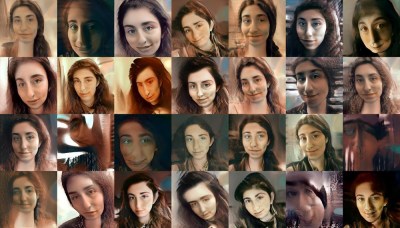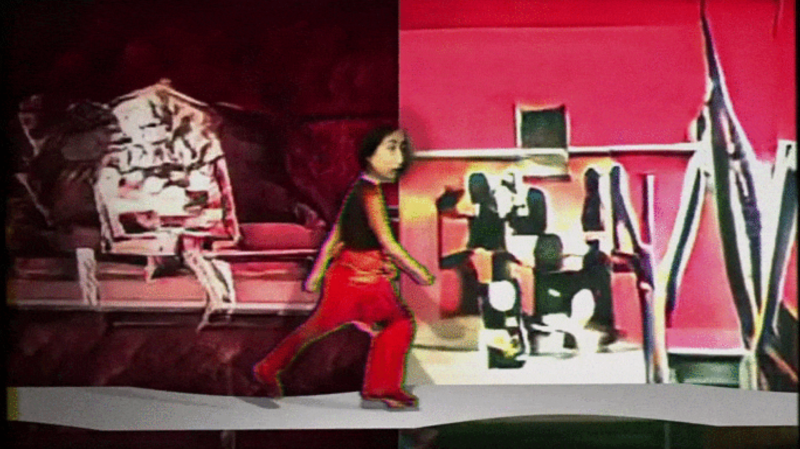Ever since we first saw the nightmarish artwork produced by Google DeepDream and the ridiculous faux paintings produced from neural style transfer, we’ve been aware of the ways machine learning can be applied to visual art. With commercially available trained models and automated pipelines for generating images from relatively small training sets, it’s now possible for developers without theoretical knowledge of machine learning to easily generate images, provided they have sufficient access to GPUs. Filmmaker [Kira Bursky] took this a step further, creating a surreal short film that features characters and textures produced from image sets.
She began with about 150 photos of her face, 200 photos of film locations, 4600 photos of past film productions, and 100 drawings as the main datasets.

On the other hand, the results of training the film set photos on models of faces and bedrooms produced abstract textures and “surreal and eerie faces like a fever dream”. Perhaps, unlike the familiar anchors of facial features, it’s the lack of recognizable characteristics in the transformed images that gives them such a surreal feel.
[Kira] certainly uses these results to her advantage, brainstorming a concept for a short film that revolves around her main character experiencing nightmares. Although her objective was to use her results to convey a series of emotionally striking scenes, the models she uses to produce these scenes are also quite interesting.
She started off by using the MiDaS model, created by a team of researchers from ETH Zurich and Intel, for generating monocular depth maps. The results associated levels inside of an image with their appropriate depth in relation to one another. She also used the MASK R-CNN for masking out the backgrounds in generated faces and combined her generated images in Photoshop to create the main character for her short film.

Bringing the results together, she animated a 3D camera blur using the depth map videos to create a less disorienting result by providing anchor points for the viewers and creating a displacement map to heighten the sense of depth and movement within the scenes. In After Effects, she also overlaid dust and film grain effects to give the final result a crisper look. The result is a surprisingly cinematic film entirely made of images and videos generated from machine learning models. With the help of the depth adjustments, it almost looks like something that you might see in a nightmare.
Check out the result below:
















This is your brain on drugs!
This is how P. K. Dick would have made a movie!
Definitely makes me think of “Do Robots Dream of Electric Sheep?” Is this a replicant dream?
Really wish we’d interrogate whether we should be building all these things instead of just focusing on if we can. Not talking about the artist’s specific work or whatever, but AI in general. It’s gonna be Butlerian jihad time soon, Dune fans. Thou shalt not suffer a machine built in the likeness of a human mind.
Ultimately..there will be a time when we create self conscious entities .. this.. combined with genetic engineering and cyborgs..that will deeply disturb our perception to reality as we know it…. weather it will kick us to new realms and horizons or make our life a true hell.
Except none of it is original thought at all, and until a computer starts generating something, without being specifically fed input, we aren’t seeing true inteligence, even of the lowest level.
Brilliant! Thank you!
That webpage boogered up my Android tablet!
Biggest thing that annoys me about this, is that the artist takes all of the credit [4.07], the software and it’s creators are not seen as important. Heck the music and sound guy get credit but not the real heroes.
When you see a painting, how often is the makers of the paint, canvas, and brushes credited?
I used maths (because technically that is all this sort of work is) to produce over 1000 “painted” portraits of people who never existed, high quality images too, 3000 x 3000 pixels and you know what one twitter troll said “they are just photo filters” implying that anyone could do that. Hmmm… but nobody else has done that, then or since! This brings us to what Art really is, it is not the artifact rather it is the idea, if there is anything original about it then it is Art because the person who created it has just pushed out the surface of that bubble defined by humanity’s collected culture and knowledge, increased its volume. This is how you should judge a person’s efforts. Not sure if this one is art but I don’t recall seeing anything like it before and it was the improvement in technology that enabled my explorations in that area, but it was my judgement as to how to use the tools. So again it is about what the artist was thinking and communicating, its originality, not the technique or even their “skill” with it. https://pbs.twimg.com/media/ECTAQqwUcAAPbKI?format=jpg